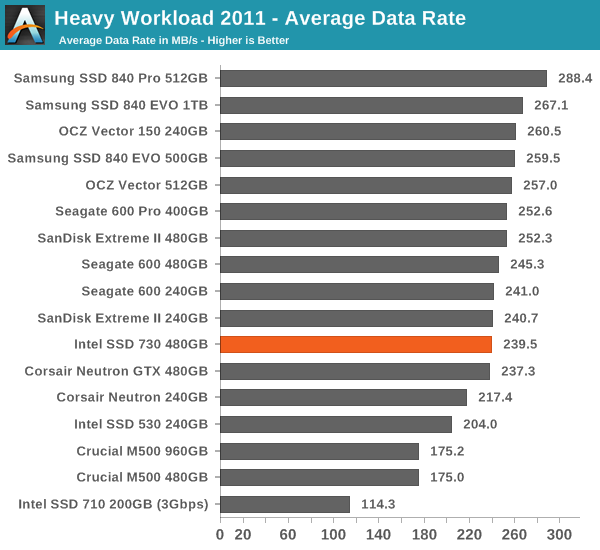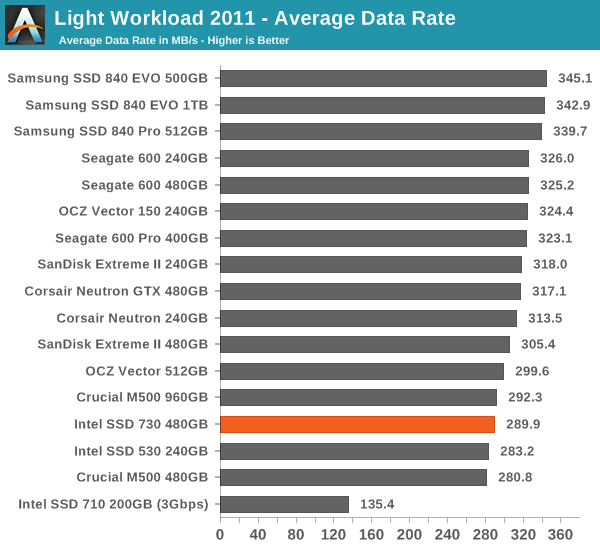Intel SSD 730 (480GB) Review: Bringing Enterprise to the Consumers
by Kristian Vättö on February 27, 2014 12:00 PM EST- Posted in
- Storage
- SSDs
- Intel
- Intel SSD 730
AnandTech Storage Bench 2011
Back in 2011 (which seems like so long ago now!), we introduced our AnandTech Storage Bench, a suite of benchmarks that took traces of real OS/application usage and played them back in a repeatable manner. The MOASB, officially called AnandTech Storage Bench 2011 - Heavy Workload, mainly focuses on peak IO performance and basic garbage collection routines. There is a lot of downloading and application installing that happens during the course of this test. Our thinking was that it's during application installs, file copies, downloading and multitasking with all of this that you can really notice performance differences between drives.
We tried to cover as many bases as possible with the software incorporated into this test. There's a lot of photo editing in Photoshop, HTML editing in Dreamweaver, web browsing, game playing/level loading (Starcraft II & WoW are both a part of the test) as well as general use stuff (application installing, virus scanning). We've included a large amount of email downloading, document creation and editing as well. To top it all off we even use Visual Studio 2008 to build Chromium during the test.
The test has 2,168,893 read operations and 1,783,447 write operations. The IO breakdown is as follows:
| AnandTech Storage Bench 2011 - Heavy Workload IO Breakdown | ||||
| IO Size | % of Total | |||
| 4KB | 28% | |||
| 16KB | 10% | |||
| 32KB | 10% | |||
| 64KB | 4% | |||
Only 42% of all operations are sequential, the rest range from pseudo to fully random (with most falling in the pseudo-random category). Average queue depth is 4.625 IOs, with 59% of operations taking place in an IO queue of 1. The full description of the test can be found here.
AnandTech Storage Bench 2011 - Heavy Workload

AnandTech Storage Bench 2011 - Light Workload
Our light workload actually has more write operations than read operations. The split is as follows: 372,630 reads and 459,709 writes. The relatively close read/write ratio does better mimic a typical light workload (although even lighter workloads would be far more read centric). There's lots of web browsing, photo editing (but with a greater focus on photo consumption), video playback as well as some application installs and gaming.
The I/O breakdown is similar to the heavy workload at small IOs, however you'll notice that there are far fewer large IO transfers.
| AnandTech Storage Bench 2011 - Light Workload IO Breakdown | ||||
| IO Size | % of Total | |||
| 4KB | 27% | |||
| 16KB | 8% | |||
| 32KB | 6% | |||
| 64KB | 5% | |||

Again, the SSD 730 comes up with relatively uninspiring performance in this lighter, older workload. If your usage patterns are relatively tame, a drive designed for enterprise usage scenarios may be more than you need and may actually end up performing slower than "lesser" drives in day-to-day use—not that you'd likely notice, as most decent SSDs are now at the point where to normal users they're all plenty fast.










96 Comments
View All Comments
Kristian Vättö - Saturday, March 1, 2014 - link
The endurance is based on a workload that consists mainly of 4KB random writes (I'm currently travelling and don't have the JDEC PDF at hand, but IIRC it was ~67% 4KB and then a variety of other IO sizes).The figures Intel provide are in-line with others. E.g. OCZ rates the Vector 150 at 50GB/day for 5 years. Consumer-grade drives are not validated as extensively as enterprise drives, hence the endurance ratings are lower. Furthermore, it's mainly a way to force enterprises to use enterprise drives because otherwise they could just throw in some consumer drives and then get them replaced under warranty when the drives wear out.
Gigaplex - Thursday, February 27, 2014 - link
"Even though the performance consistency on the SSD 730 is great, it's only mediocre in our Storage Bench 2013. The write performance of SSD 730 is class-leading but as our Storage Bench has more read than write operations, the SSD 730 loses to drives with better read performance."Uh... your graphs show it near the top of the charts for read, and in the bottom half for write. This comment makes no sense.
creed3020 - Friday, February 28, 2014 - link
Excellent point. This is review is filled with holes that tout this drive yet the numbers don't back it up.For it's price the drive is a non starter. I have a Seagate 600 240GB which I purchased for $139, that is a staggering $110 less than the 240GB equivalent here from Intel. The 5-10% performance improvement this drive has over my drive is not worth the price difference. Intel resting on it's laurels as usual.
CalaverasGrande - Thursday, February 27, 2014 - link
orientated?eanazag - Thursday, February 27, 2014 - link
What was left out of this review and it is understandable is how it handles various RAID configurations over time. More than RAID 0 or 1. I think that may be the more realistic usage model.I agree with most others. I am not seeing much traction for it because of pricing and lack of features. Maybe professionals. I'd need to look at this and the DC models to decide based on price.
bitcoder - Friday, February 28, 2014 - link
I agree on the RAID comments, since this is an "enterprise" ssd lets see how it works in tougher environment. Put some in a RAID configuration and then compare them against the other RAIDed drives in your bin. Consistent performance is a critical parameter when you put drives in parallel as the slowest one on any operation slows down the whole array.I disagree on the lack of features, I think a power loss (backup power caps) is much more likely than computer theft (encryption) of a desktop at my house. Maybe they had to turn off encryption because it was the slowest part of the silicon and prevented reaching these overclocking speeds.
chizow - Thursday, February 27, 2014 - link
Great synopsis and analysis of the evolution of SSDs since Intel's X-25M hey day, just as I recounted the events as well for the most part.I just don't see how Intel will sell many of these at the listed MSRPs, from what I saw it is still slower than the top 3 SSDs on the market (Samsung 840Pro, Sandisk Extreme II, Samsung 840Evo 250+GB) and it is much later and more expensive than the Extreme II and 840 Evo at least.
iwod - Thursday, February 27, 2014 - link
I am slightly disappointed.The Intel DC brings SSD Random IO consistency to the table. At the time where you can actually still feel pause on some pretty decent SSD. It was good because we reached the upper limit of Seq Performance with no replacement for SATA 6Gbps in sight, and Random Read Write has nearly level off between most SSDs.
Since then, most other top end SSD, from Latest Marvel Controller to Samsung has all provide very good consistency. As shown in the graph SANDISK Random IO variation are all well within 1x% range. And doesn't have Dot jumping everywhere on the graph. The same goes for Samsung as well. While Intel still brings the best consistancy performance, but it doesn't seems to me the tradeoff are worth it. From performance enthusiast perspective, Seq and Random IO still comes first. As shown in the Storage Bench the SSD 730 isn't the top performer, the highest power usage, and the most expensive as well.
What we need now is improvement on all front. Much faster Seq Performance, even PCI-E 3.0 x 2 will only brings us 2GB/s, which i guess will only take a year and half for SSD marker to saturate it. Faster Random IO, and finally much lower Power usage.
Samus - Thursday, February 27, 2014 - link
Considering you can buy two m500 drives for the price of one of the 730's, your better off raiding them together and getting superior performance, endurance, redundancy, and far less idle power consumption.Cost aside, this controller makes no sense for anything but a SQL, Exchange, web or heavy IO file server. The only desktop platform that'll take advantage of the performance consistency is video editing, but at 240 and 480 GB the capacities aren't high enough.
amddude10 - Friday, November 28, 2014 - link
The 730's power loss protection is supposedly much, much better than that of the m500